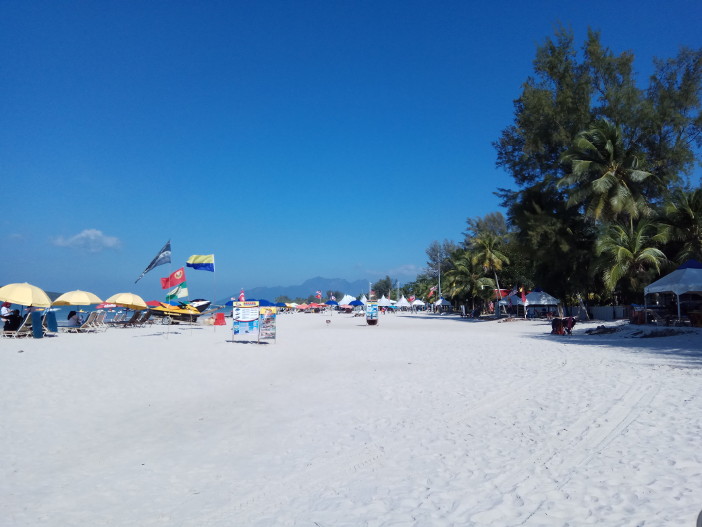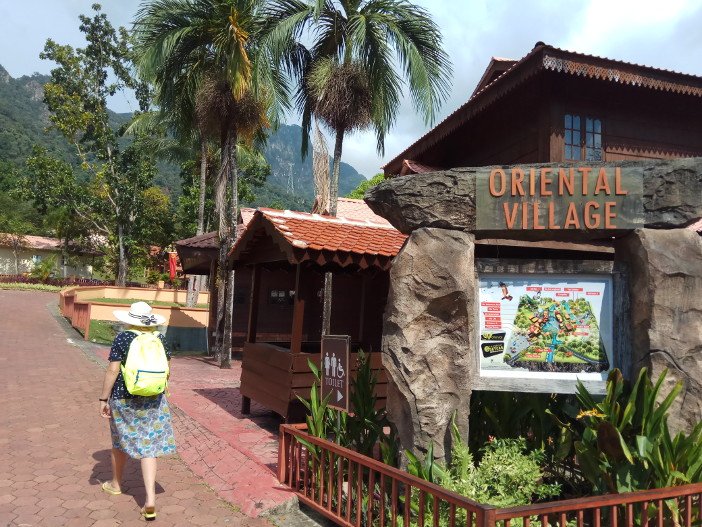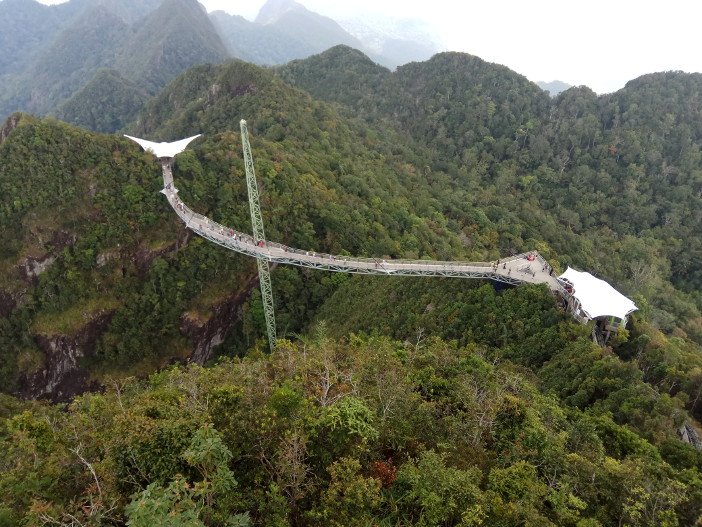Basking on the Beaches, Hills, and Among the Wildlife of Langkawi, Malaysia
After a few days in KL, we headed for the island of Langkawi for some rest and recuperation, at the end of a long 2017. Langkawi lies off the west coast of the Malay peninsula, close to Thailand, in the Andaman sea. Until the 1980s it was an undeveloped backwater, but then the government scrapped all duty taxes there. The aim was to kickstart tourism, and the move was wildly successful. The island is now buzzing not only with tourists but also with mainlanders coming over to shop for bargains.
The airport is still fairly small, and flights are mostly local. We opted to travel through KL as we wanted to see the capital too, but there are direct flights to Langkawi from Guangzhou, and that may be a quicker route from Beijing. It’s a dramatic arrival, with the plane descending over the sea, and you can almost see the holidaymakers on the beaches below. A budget alternative is to take the bus and the ferry from KL.
There are two main settlements in Langkawi. The capital Kuah is a small town, with not much to recommend it to visitors. We went there to check out the Langkawi Parade “Megamall”, but it’s small and dingy by Chinese standards, and not really worth the trip.
Better shopping is available in the duty-free stores of Pantai Cenang, which is the main tourist town. (“Pantai” means “beach” in Malay.) The main drag along the seafront is packed with shops, restaurants and “tourist information” offices selling activities and excursions.
Beyond Pantai Cenang are many smaller beaches and self-contained holiday resorts. There’s not much in the way of public transport on Langkawi; taxis are cheap if you can find one, but most people rent scooters or cars to get around. Make sure you have your driving license with you as police checkpoints are common. And remember you’re no longer in China – they drive on the left, and seatbelts are compulsory.

The beaches are wonderful, with soft sand and gentle waves, but you need to be careful of jellyfish (more on this later). Because of its location sheltered by the mainland, there is no real rainy season in Langkawi. When we visited, at the end of December, there were a few days of heavy rainfall, but for the most part glorious sunshine. The hottest part of the day, we discovered, is not around midday as we expected, but from 2 to 4 in the afternoon.
One of the delights of Langkawi is that, while the beaches have all the juice shacks and bucket-and-spade shops you could wish for, much of the island remains completely wild. On Langkawi itself there are two “geoforest parks” of protected woodland, and there’s a third across on the nearby islands of Pulau Tuba and Pulau Dayang Bunting.
My children love animals, but we decided to avoid the Wildlife Park, the Crocodile Park, and the Underwater World in Pantai Cenang. The animals there are for the most part not native to the island and are not kept in natural conditions. It seemed unnecessary to pay money when there was so much natural wildlife around.
We were staying in a chalet a mile or so from the beach, and even there we were virtually surrounded by rainforest. Most exciting for the kids was the family of monkeys which lived nearby, and often visited to chew on the delicious leaves of the hotel’s garden. The hotel owner would chase them off, as they damaged the roofs of the chalets by running along them, but my children loved to see them.

These were dusky leaf monkeys. The island’s other native species of monkey are macaques; larger, more fearless and more destructive. These primates are so used to humans that they would only move out of the way of our approaching car after much honking on our part, and much attitude and scowling on theirs. We watched a pack of macaques surround a picnicking family and steal their food in a coordinated attack – one would distract the humans while another moved in to grab anything they could.
The macaques associate plastic bags with food. One of them charged hissing at my younger son because it thought he might try to take away the bag of chili sauce it had fished out of a bin. I rapidly stopped finding them in any way cute or charming, especially after I saw an adult monkey punishing a juvenile by pulling its tail around a fence post until the little one was screaming in pain. If you see macaques, stay well clear, look after your plastic bags, and above all don’t feed them – they don’t need encouragement.
If you’re really lucky you might also see the flying lemur, so called because it’s not a lemur and it doesn’t fly. In fact, it’s not even a primate, but a different branch of the evolutionary tree which now has only two surviving species, called colugo. The colugo has flaps of skin under its arms which enable it to glide from tree to tree. We weren’t fortunate enough to see one in the wild, but a guide on an excursion had one as a pet, and my children were fascinated by this rare, unusual (and extremely cute) little beast.
Even more spectacular than the mammals were the birds. The common myna turned out to be common indeed, as we saw it everywhere, but we also spotted sunbirds, egrets, orioles, and kingfishers. The Great Hornbill is the national bird of Malaysia, and it was a thrill to observe one perching in a tree near our chalet. Langkawi meanwhile takes its name from the Brahminy Kite, which could often be seen soaring above, looking for prey.

Geckos were everywhere, including in our rooms, as were some spectacularly large beetles (those who prefer a sanitized environment might decide that Langkawi isn’t for them). Sadly the only snakes we saw were roadkill; apparently, the tarmac retains the heat of the day, and the snakes creep out at night to enjoy the warmth, only to be crushed by the wheels of passing cars.
However, there is one animal common around Langkawi that you definitely don’t want to run into and one we had been warned about, not before we went of course; the tourist industry keeps very quiet about them: jellyfish.
It wasn’t until we were picked up at the airport by our host, that the subject was mentioned. Another guest had been stung once and had a bad reaction, he told us, so we should be careful.
“But of course it’s not the season yet,” he said. “From January to June you probably shouldn’t go out swimming without a proper stinger suit on.”
This came as something of a shock to us. We love to swim, and had planned to go in the sea pretty much every day. But we had never even seen a “stinger suit,” let alone brought one with us.
We decided to do the sensible thing, and act like nobody had ever told us. We went swimming every day, just a little more warily, imagining gelatinous tentacles all around.
But jellyfish don’t have calendars, and they weren’t waiting for Jan 1.
By chance I wasn’t there when it happened, having picked up a sore throat which left me with no voice that day and no enthusiasm for swimming. So the first I knew of it was when I heard Noah’s feet pounding up the path.
“Dad!” he yelled before he’d even got through the door. “Mom and Joseph have been stung by a jellyfish!”
The owner of the hotel we were staying at kindly loaned me his car, and we went whizzing off in search of the casualties.
“They shouldn’t be walking!” I croaked, remembering the fragments of jellyfish lore I had picked up. “It pumps the venom round the body!”
We found them down the road. The hotel owner had also provided us with a bottle of vinegar, and I proceeded to pour it over their arms, encouraged by a bystander. This appeared to make Joseph’s sting immediately better, but Karen’s if anything worse.
Then we set off for the clinic, desperately trying to remember the directions which had been shouted to me as I ran to the car. I found the clinic, deposited them there, then had to go back for our passports. I come from a country where, if there’s something wrong with you, you go to the hospital and they fix it, no questions asked. This has rendered me a useless child when it comes to international travel.
When I got back to the clinic, all was much calmer. They were quickly seen, given ointment and pills, and I was presented with a bill well within the excess for our travel insurance: only RMB 300 for both of them. When I saw that they had only been prescribed calamine lotion and antihistamines, I was even more relieved. Clearly, this was not a deadly sting.

Later, over dinner, I told my colleagues via WeChat what had happened.
“Pee on it!” I was urged. “Pee on it right now!”
“I don’t think that would go down well with the other people in the restaurant,” I answered.
For the record, the current advice is that you don’t pee on the sting, though vinegar is indeed recommended.
Moving on – or up – the most important piece of advice if you’re thinking of visiting Langkawi’s cable car is to check whether it’s running before you set out. It seemed a fine day on our first attempt, but we arrived to learn that the cable car was closed due to high winds. (Later, when we made it to the top of the mountain, we came to appreciate how a gentle breeze below could become a serious gust at higher altitudes.) It’s also prone to close for maintenance unpredictably – though this too is a precaution you’ll appreciate when you’re dangling hundreds of feet in the air.

When we finally made it there on a day it was actually open, our next challenge was to survive the queues. The base station is surrounded by an “Oriental Village”, a distinctly Chinese-style area of lakes, bridges, and many, many shops. You can avoid being steered around this retail park by taking a left as you enter from the car park, where a short-cut takes you straight to the cable car.
We waited a perfectly acceptable 10 minutes or so to buy tickets, which state the time at which you should go to the station. So far, so good. There’s a bewildering array of ticketing options, including a line-jumping priority pass which adds RMB 100 to the cost. We’d opted for a ticket which also gave us admission to various other attractions, so we filled in the time by visiting “3D Art Langkawi”.

This turned out to be one of those “optical illusion photo opportunity” attractions so beloved of the Asian tourist industry. There’s also the mandatory baffling laser show, which in this case was about a carpet having a fight with an eagle while an Egyptian pharaoh shot laser beams from his eyes. Or something.
We returned just in time, to find that we had missed our slot because they’re actually called 15 minutes ahead of time, as had been explained by nobody. We joined a huge chaotic scrum around the cable car station, and seethed at the people blatantly cutting in. Only just in time did we realize that they were all standing around for no reason at all. Once your time slot has been called you just go to the barrier, where you pass through to the real queue.
Fortunately, nobody complained that we were late. After another wait of 20 minutes we were in the gondola and away. There’s a stop halfway with a viewing platform before you queue up again to ascend to the peak. The cable car claims to be the “steepest on earth,” and it certainly provides dramatic sights as it sweeps over the virgin rainforest.
At the top, there are more viewing platforms, and the “Sky Bridge,” one of those glass-bottomed viewing platforms also beloved of the Asian tourist industry. Fortunately, our tickets did not include admission, so I was spared displaying my embarrassing fear of heights. Instead, we admired the spectacular views from the summit, enjoyed a drink at the café, and headed back down.

Although I’d been less than keen on the other attractions (a 4D dinosaur theme park and a less impressive virtual spaceship ride), the package overall was good value, and we spent most of the day there. If you fancy a change from lazing on the beach, then it’s certainly worth a trip. Just remember to check it’s actually open.
This article originally appeared on our sister site beijingkids.
Photos: Andrew Killeen, Phalinn Ooi via Flickr, bnanative via Flickr, Andrew Killeen
Related stories :
Comments
New comments are displayed first.Comments
![]() AndrewKilleen
Submitted by Guest on Thu, 04/26/2018 - 22:50 Permalink
AndrewKilleen
Submitted by Guest on Thu, 04/26/2018 - 22:50 Permalink
Re: Basking on the Beaches, Hills, and Among the Wildlife of...
I drove around Langkawi, and found it easy (though it helps that I'm British and used to driving on the left!) I don't think I'd want to try it in KL though.
![]() Langkawicarhire
Submitted by Guest on Tue, 04/24/2018 - 20:37 Permalink
Langkawicarhire
Submitted by Guest on Tue, 04/24/2018 - 20:37 Permalink
Re: Basking on the Beaches, Hills, and Among the Wildlife of...
To a foreigner, the very idea of driving in Asia conjures up images of millions of motorbikes, cars coming from all directions, rickety trucks and buses, and speed, speed, speed!
Many tourists have seen the traffic (and experienced the fear of even crossing the road) in cities such as Bangkok and Kuala Lumpur. So when travel experts suggest that hiring a car is the best way to get around Langkawi in Malaysia, many potential visitors become quite nervous even at the thought of it.
Validate your mobile phone number to post comments.







